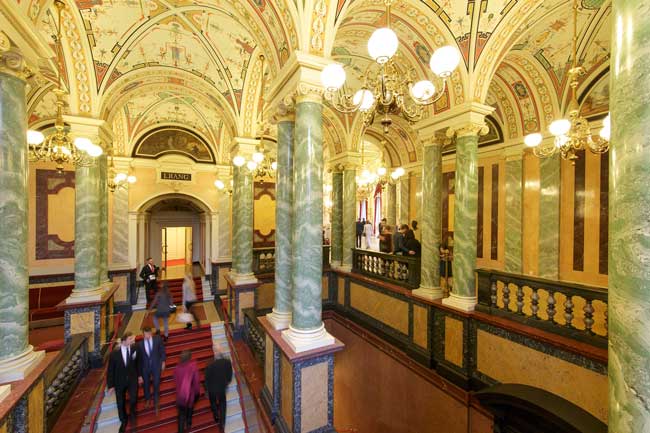
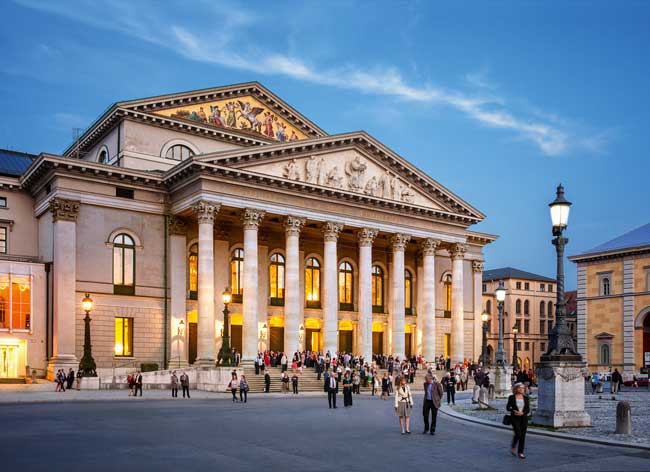
The Munich National Theater
My spine tingled as I walked up the steps and between the Greek-style columns of Munich’s National Theater, home of the world-renowned Bavarian State Opera.
I’m an orchestra musician, and entering this opera house was an almost spiritual experience akin to going into a cathedral.
However, like many world travelers, this was the first time I had attended a live performance in one of Europe’s historic venues.
In the foyer, people surged around me. I wanted to gaze at the sculpted bust of composer Richard Strauss—I’d come to see his famous opera, Der Rosenkavalier—but I was in a hurry.
In 25 minutes, I needed to find the Ring II level where my seat was located, change out of my sightseeing clothes, leave my coat and day-pack at the coat check.
Then settle into my seat before the lights dimmed and the conductor gave the downbeat.
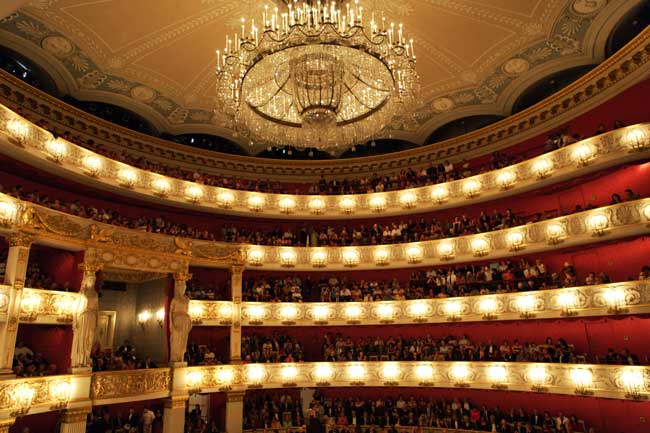
Opera in Germany
Germany has one of the richest musical traditions in Europe, and it’s home to some of the world’s most magnificent opera houses, many of them architectural treasures that are at least 150 years old.
So, I decided to plan my trip to Germany around opera. I chose Munich and Dresden—just two of Germany’s many cities where opera thrives and is enthusiastically attended by both locals and international visitors.
As a bassoon player, I’m biased toward classical music, but I want everyone to love it as much as I do.
Some people are put off by opera’s high-art reputation, but the truth is that operas were written to entertain everyone, and most of them have simple, melodramatic stories.
Usually involving forbidden love, or murder, or both!—that hook you. And opera has universal appeal.
Although it’s sung in Italian, French, German, Russian, Czech, and English, it transcends borders. And that’s why we travel in the first place.
Munich’s Bavarian State Opera
An English-speaking usher showed me to my seat in the front row of Ring II, which was beside the Royal Box where Bavarian kings once sat.
My heart fluttered as I gazed up at a massive crystal chandelier and an ornately decorated ceiling.
The theater walls were covered in red silk; lighting sconces were ornamented in floral and leaf motifs. To my right was a giant, sculpted Greek goddess whose figure embellished an architectural column.
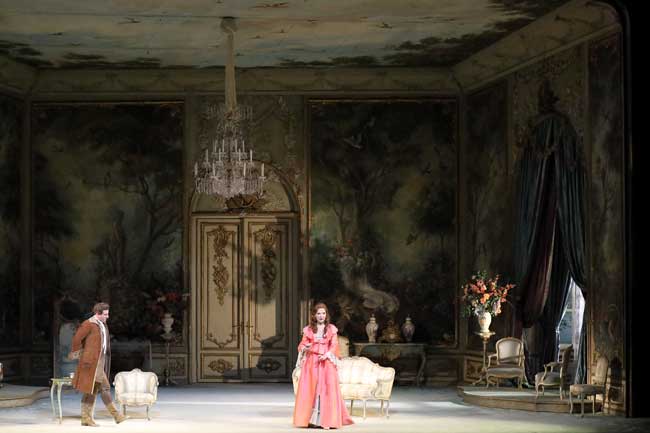
Feeling rather royal myself, I looked down at the seats below as they rapidly filled with people; the performance was sold out.
I also assessed the orchestra as the huge assemblage of instrumentalists required to play Strauss’ soaring score warmed up.
As the lights dimmed, I glanced through the program: the synopsis was in German, which I couldn’t read. After the overture, the red-velvet curtain opened to reveal an opulent palace set, and Der Rosenkavalier began.
The Love Triangle Opera
The three-act romantic comedy is about a love triangle between an aging noblewoman, her young lover Octavian (a “trouser” role, in which a woman with a mezzo-soprano voice sings the part of a boy/man), and the girl Octavian eventually falls in love with.
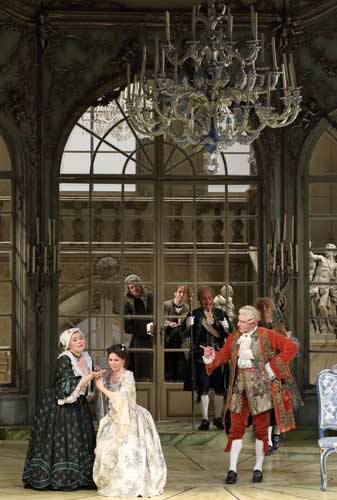
The singing was divine; the costumes were lavish; the orchestra sounded superb.
My only disappointment was that the supertitles—the translations of the lyrics projected above the stage—were in German only. No English as I had hoped.
Luckily I had prepared by watching a DVD version of Rosenkavalier the week before I left home.
I was familiar with the story and the basic content of the lyrics. (If you’re attending any live opera, even one with English translations.
I highly recommend watching at least the first act in advance. And if your program is in German only, you can easily find the opera’s synopsis online.
I prefer the Metropolitan Opera’s accounts of characters and plots.)
Before I knew it, the first act was over, and during the first 40-minute intermission, I queued up at the bar for canapés and a glass of wine.
I hadn’t had time for dinner beforehand—and the whole production, including two intermissions, clocked in at 4.5 hours.
As I nibbled and sipped, I meandered the King’s Halls: high-ceiling rooms connected by marble staircases and illuminated by more crystal chandeliers.
The People At Opera
I spied a few women in sparkly gowns, although most people were more casually dressed. A few wore jeans, which made my easy-to-pack black skirt and sweater feel just right: not overdressed but not shabby.
I even had time to view portraits of the famous sopranos and baritones who have sung at the theater during its 200-year history.
The second and third acts each had brand-new sets and costumes but always the same exquisite singing.
I confess that because of jetlag, I had trouble keeping my eyes open a couple of times, but I always perked up when the music’s tempo changed.
At the end of the evening, I opted to take a taxi back to my hotel, which was outside the city center, despite the convenience of not one but two different U-Bahn stops just a five-minute walk from the theater.
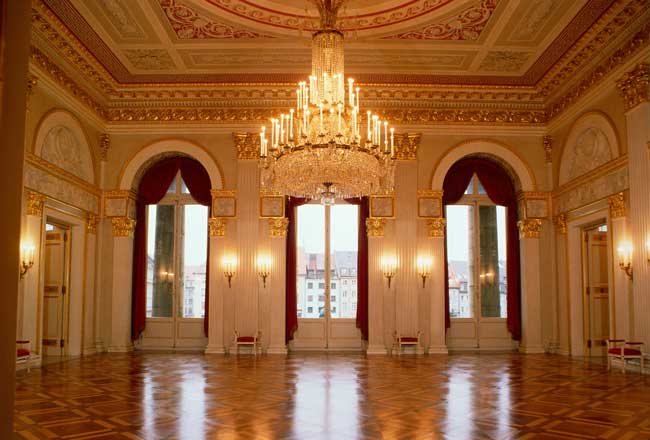
The Next Day
The next day, I was still humming arias from Der Rosenkavalier when I returned for a tour of the National Theater.
It included a backstage peek at the frenetic behind-the-scenes workings. Crews were positioning sets for an upcoming world premiere, and techies strode around checking light positions.
The guide told stories about the Bavarian State Opera: My favorite was about “Mad” King Ludwig II, who long ago sat just yards from the seat I occupied.
Though he loved opera, Ludwig couldn’t bear for the audience to stare at him. His solution was to close the Royal Box drapes and peek through—but from behind the curtains, the music was muffled.
So, he arranged for a private performance in the middle of the night with no audience in attendance, but the sound echoed through the hall.
Ludwig finally achieved perfect acoustics by filling the theater seats at midnight with soldiers.
Their commander, the king ordered them not to turn around or look up at him before, during or after the performance! Such are the lengths that opera lovers will go to.
Also of Interest in Munich: Adjacent to the National Theater is the Munich Residenz, the former royal palace of the Bavarian monarchs, which is now a museum.
Inside the Residenz is the 18th-century, rococo-style Cuvilliés Theater, a small jewel once used only by royalty.
Today you can view the interior while you’re in the museum or attend a chamber concert or small-scale opera.
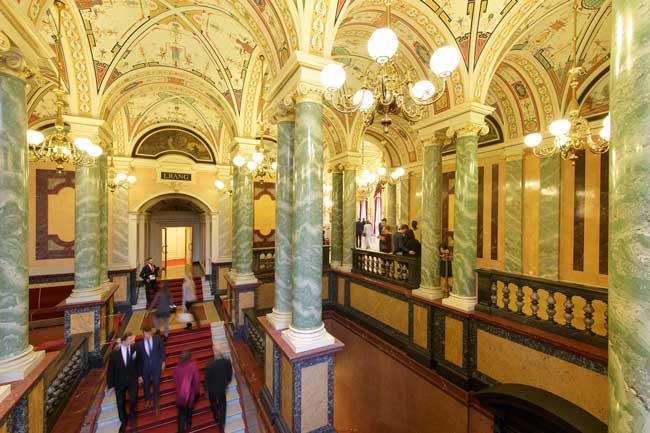
Semper Opera in Dresden
Primed for even more opera, I took the Inter-City Express train from Munich to Liepzig and then on to Dresden, where Mozart’s The Magic Flute—a comic fairy-tale opera in two acts—awaited.
There, the Neo-Renaissance-style Semper Opera House presides like a queen over the historic town center’s Theaterplatz (Theater Square).
There’s also the Zwinger Palace and several museums, including the Old Masters Picture Gallery.
I was lucky enough to get a room at the nearby Hyperion Hotel Dresden am Schloss, so I was just a 10-minute walk from the object of my operatic affection.
I also discovered how convenient it is to dine near the opera house before a performance.
I enjoyed a quiet dinner before the show in the sophisticated Café Alte Meister, which is maybe 50 yards from the Semper Opera.
And before taking a daytime tour of the opera house, I ate lunch at the nearby Sophienkeller, a tourist-oriented eatery with 18th-century décor and costumed servers, which, despite the kitsch, served quite satisfying food.
On the English-language tour of the magnificent Semper Opera, named for architect Gottfried Semper, I learned about its three incarnations.
Originally built in 1841, the rococo opera house wowed European audiences, but it burned down in 1869 and wasn’t reconstructed until 1878.
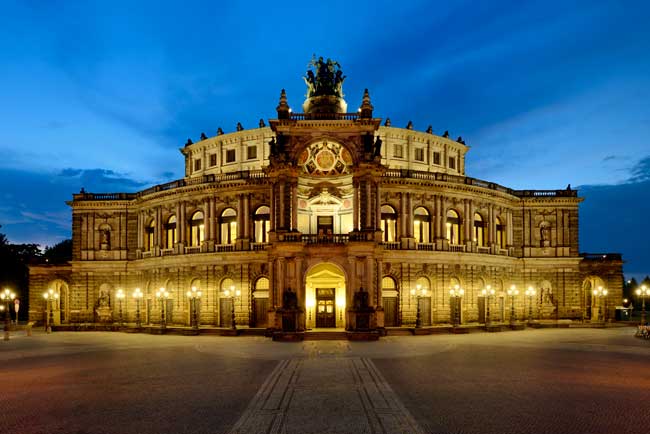
Tragedy struck again when the theater was almost entirely destroyed during the Allied bombing of Dresden during WWII.
For 40 years it lay in ruins, but in the 1980s, under the East German communist government, restorers painstakingly recreated nearly every detail of the former structure.
The guide pointed out frescoed ceilings from Greek mythology and paintings that depicted scenes and characters from famous German operas.
Our group oohed and aahed over the balustrades made of serpentine stone and the green “marble” pillars that are actually built from brick covered with plaster, glue, and paint—then polished so that they gleam like marble.
I also got a preview of the theater, which is dominated by a 1.9-ton chandelier that can be lowered from the ceiling for cleaning and to change its 258 light bulbs.
The Magic Flute
While we watched, stagehands finished preparations for the evening’s production of The Magic Flute.
That night, from my seats in Ring 1, I experienced a creative and beautifully sung production of Mozart’s most famous opera.
This time the supertitles projected above the stage were in both English and German. Set in a cartoonish fantasyland that reminded me of Tim Burton’s Edward Scissorhands and Pee-wee’s Playhouse.
The offbeat style of this version of The Magic Flute contrasted with the stately historic theater, illustrating how a 225-year-old opera can be successfully re-imagined without changing a note of Mozart’s masterwork.
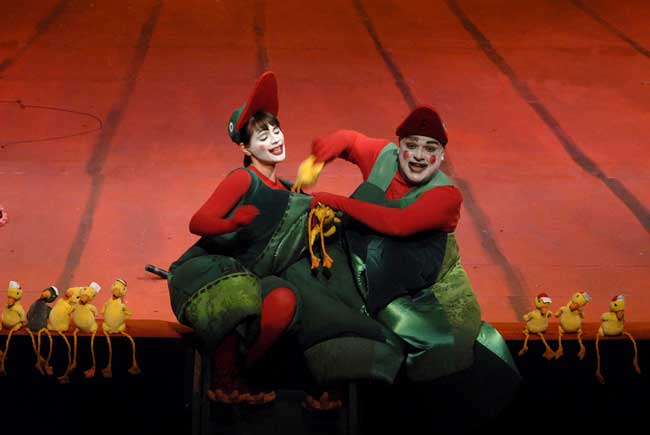
A highlight of the vibrant and colorful production was the stratospherically high aria sung by the Queen of the Night, whose performance was breathtaking.
When she finished singing, the applause was thunderous. Afterward, as I walked across the cobblestones of the Theaterplatz—along with dozens of other opera patrons—and headed back to my hotel, those notes stayed with me.
I hear them still as I await some future trip to Germany, when I know a fresh infusion of operatic inspiration awaits.
Also of interest in Dresden: If heavy, sometimes tragic, operas aren’t your thing, the Dresden State Operetta, which stages a mixture of light operas and popular musicals, might be more to your taste.
In late 2016, the operetta company moved into Dresden’s new Kraftwerk Mitte theater complex, built into a retrofitted Soviet-era power plant. Its artsy/industrial atmosphere is as fun as its repertoire.
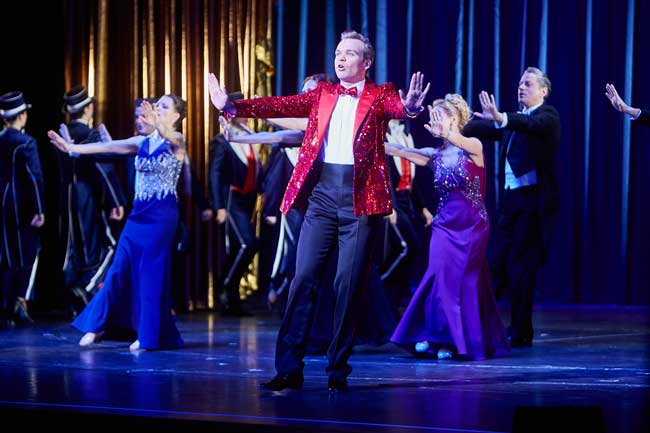
Here you can see everything from Catch Me If You Can and Le Cage aux Folles to The Marriage of Figaro, The Merry Widow and Orpheus in the Underworld.
(Be aware that if you see a Broadway musical staged by the Dresden State Operetta, it will be performed in German for its local audience. However, English titles are provided.)
READ Tips for Attending the Opera in Germany
Going to the opera is a little like sampling the food in a different country: it may be hard to read the menu, but if you give it a try, you’re sure to find something you like.
Here are some of my tips to help demystify the experience for international travelers. READ How to Attend the Opera in Germany
If You Go to Germany
For further information on travel in Germany, see Germany.Travel
Author Bio: Freelance writer Laurel Kallenbach plays bassoon and is working on a novel about opera musicians.
